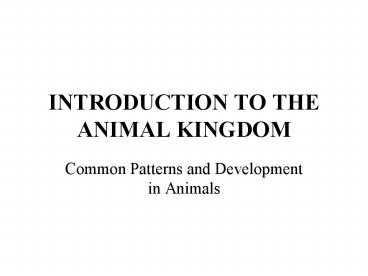INTRODUCTION TO THE ANIMAL KINGDOM PowerPoint PPT Presentation
1 / 53
Title: INTRODUCTION TO THE ANIMAL KINGDOM
1
INTRODUCTION TO THE ANIMAL KINGDOM
- Common Patterns and Development in Animals
2
What Are Animals?
- Animals are multicellular
- Eukaryotic
- Heterotrophic by ingestion (usually)
- Four key branch points
- 1. Parazoa (No Tissues) vs. Eumetazoa (Tissues)
- 2. Radiata vs. Bilateria (Body Symmetry)
- 3. Acoelomate vs. Coelomate (Body Cavity
Present) - 4. Protostome vs. Deuterostome (Development)
3
Two Main Body Plans
4
Early Embryonic Development
5
(No Transcript)
6
Bilateral Body Plans
- Must have 3 germ cell layers Ectoderm,
mesoderm, and endoderm. - Body cavity may be fully-lined, or
partially-lined with mesoderm.
7
Animal Phlogeny Review
8
Animal Phylogenetic Tree
9
Phylum Porifera (Parazoa)Animals with porous
bodies
10
Early Choanocyte Organism May Have Preceded
Sponges
11
Sponge Anatomy
12
Summary of Poriferan Characteristics
- No true tissues. Cell layers are loose
federations of cells. - Sessile life cycle.
- Filter feeders. Water drawn in and filtered by
choanocytes (collar cells). - Central cavity called the spongocoel.
- Excurrent opening called the osculum.
- Contain wandering amoebocytes.
- Sexual reproduction. Most are hermaphroditic.
- Internal support by spicules SiO2, CaCO3 or
spongin.
13
Pylum Cnidaria (Stinging-celled Animals)
14
Body Plan of Cnidarians
15
Nematocysts Capture Prey
16
Cnidarian Life Cycle
17
Free-Living Medusa (Jellyfish)
18
(No Transcript)
19
Summary of Cnidarian Characteristics
- Radial symmetry.
- Two germ cell layers (Ectodern and endoderm).
- Primitive nerve net of cells coordinates
movement. - Sessile life style for some forms.
- Body cylindrical with tentacles around a mouth.
- Gastrovascular cavity for digesting prey.
- Sexual reproduction or asexual reproduction by
budding. - Nematocysts present Signature stinging cells
on tentacles
20
Phylum Platyhelminthes (Flatworms)
21
Flatworm Body Plan
22
Parasitic Flukes
23
Tapeworm Lifecycle
24
(No Transcript)
25
Phylum Nematoda (Round Worms)
C. elegans
26
Summary of Nematode Characteristics
- The most numerous soil animals with thousands per
liter of soil - Dimorphic Separate male and female forms
- Not segmented
- Covered by a cuticle.
- Complete digestive tract but no circulatory
system. - Pseudocoelom partially lined with mesoderm.
- Caenorhabitis elegans, DNA fully sequenced and
development known cell-by-cell. - Pinworm, hookworm, Trichinella spiralis
27
Parasitic Nematode Lifecycle
28
Phylum Annelida (Segmented Worms)
Marin Polychaete
Marine Christmas-tree worm
Leech
29
Earthworm Anatomy
30
Summary of Annelid Characteristics
- Segmented body plan.
- Majority are free-living in all environments.
- Complete coelom, though segmented by septa.
- Earthworms have closed circulatory system and all
other systems are well developed. - Hermaphroditic, but only cross-fertilize.
- Each segment contains a pair of metanephridia.
- Three classes Earthworms, polychaetes, leeches.
- Protostome development.
31
(No Transcript)
32
Phylum Mollusca (Soft-bodied Animals)
33
Mollusca Are A Diverse Phylum
34
All Mollusks Have a Similar Body Plan
35
Clam Body Plan
36
Summary of Mollusk Characteristics
- Bilateral symmetry.
- Coelomate
- Complete digestive tract, but open cirulatory
system. - Many have shells either single or double
(bivalves). - Protostome development.
- Possess a mantle and muscular foot.
37
Phylum Arthropoda (Jointed-leg Animals)
38
Summary of Arthropod Characteristics
- All possess an exoskeleton composed of chitin
with jointed body and appendages. - Open circulatory system.
- Bilateral symmetry with true coelom.
- Protostome development.
- Some born as immature nymphs (small versions of
adults), others born as larvae which undergo
metamorphosis to adult form. - May be classified by body segments, number of
legs, mouth parts, or development.
39
(No Transcript)
40
Arthropod Body Plan
41
Insect Body Plan
42
Arachnid Body Plan
43
Phylum Echinodermata(Spiny-skinned Animals)
44
Echinoderm Anatomy
45
Summary of Echinoderm Characteristics
- Radial Symmetry (larval stages may be bilateral)
but may have evolved from bilateral ancestors. - True coleom.
- Deuterostome development.
- Possess a water vascular system with tube feet
for locomotion. - All marine.
46
Phylum Chordata
47
Summary of Chordate Characteristics
There are five main chordate features. These
features are frequently temporary, only appearing
during embryonic development.
- Notocord present Dorsal, flexible rod or
cartilage functioning as support. Usually
replaced by bone in most chordates. - Dorsal hollow nerve cord Forms basis for
nervous system. May become brain and spinal
cord. - Pharyngeal gill slits May become gills, or
features of the head. - Muscular tail Extends beyond the digestive
tract. Often lost in development. - Somites present Muscle segments blocks of
mesoderm. Chordates are segmented animals.
48
Dorsal Nerve Cord Develops From A Fold In The
Dorsal Embryonic Ecotoderm
49
Phylum Chordata - Chordates
50
Lancelet Anatomy
51
Tunicate and Tunicate Larva(Primitive Chordate)
Larva
Adult
52
Classes of Subphylum Vertebrata
- Agnatha Jawless fish Hagfish, lampreys
- Chondrichthyes Cartilaginous fish Sharks,
rays, skates - Osteichthyes Bony fish
- Amphibia Salamanders, frogs, toads
- Reptilia Snakes, turtles, crocodilians
- Aves Birds
- Mammalia - Mammals
53
THE END

